
Tunis: Impressions of Journées Théâtrales de Carthage
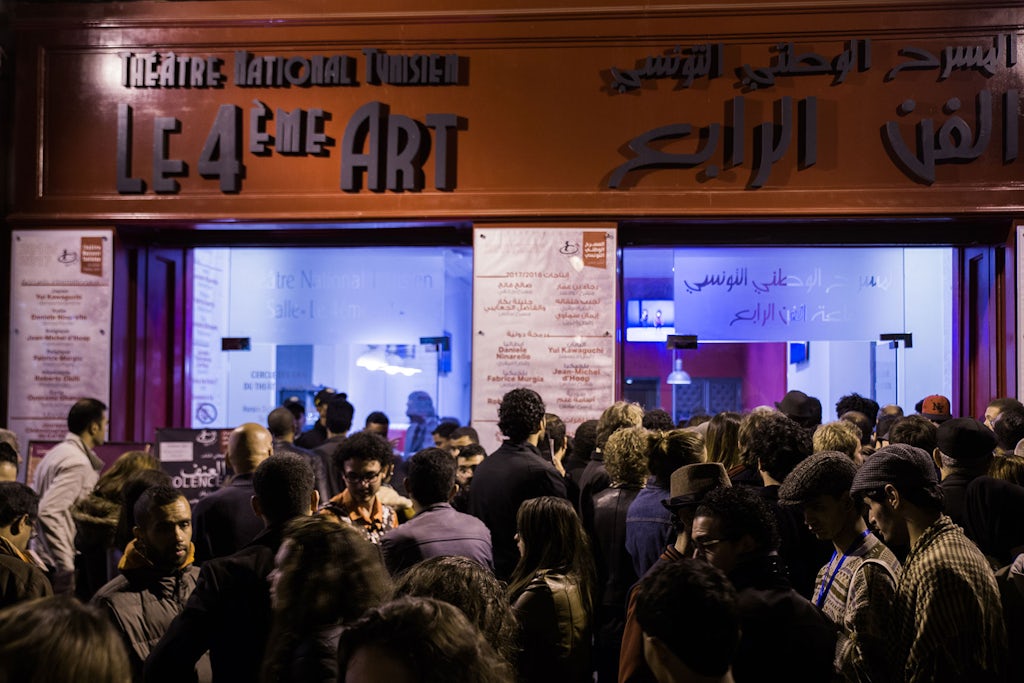
Le Quatrième Art, Tunis
Kunstenpunt / Flanders Arts Institute was invited for the professionals programme of the festival Journées Théâtrales de Carthage (JTC) in Tunis, a good opportunity to get to know the local performing arts sector. After all, we want to intensify our collaboration with countries from North Africa.
Deze tekst is enkel beschikbaar in het Engels.
After all, we want to intensify our collaboration with countries from North Africa. In my suitcase: a travel guide that describes Tunisia as a land of milk and honey where no conflict worthy of mention has ever taken place, and a travel advisory from the Ministry of Foreign Affairs that simply advises against going to Tunisia: “if you don’t need to be there, stay home”. Articles by Joachim Ben Yakoub – a researcher at UGent and member of MENARG (Middle East and North Africa Research Group) who is writing a PhD on the role of art in the context of the Tunisian revolution – make for more interesting reading material.

Crossroads of cultures
The Journées Théâtrales de Carthage is the most important theatre festival in Tunisia. A biennial edition has been held since 1983; from now on the festival will take place annually, this year being the 18th edition. The festival is a state festival, although, according to outgoing director Lassaad Jamoussi, the state no longer interferes in the artistic programme. The festival lasts nine days, during which 62 shows are put on: 18 from Tunisia, 17 from the Arab world, 10 from Africa, and 17 from the rest of the world. The festival also has a ‘decentralisation policy’: a lot of shows are performed in the various regions, on the grounds that ‘all Tunisians have a right to culture’. The focus in this respect is mainly on an audience of pupils and students. Jamoussi sees his festival as a crossroads between Arab and African culture and the rest of the world.
The festival centre (for professionals, at least) is located in the impressive Africa Hotel on Avenue Habib Bourguiba, somewhere between the heavily guarded French Embassy and the place where last year 12 officers of the presidential guard were killed in an attack.
A strong Flemish delegation is in attendance: the shows ‘In the Eyes of Heaven’ by Ruud Gielens (Moussem/Kaaitheater) and ‘Body Revolution’ and ‘Waiting’ by Mokhallad Rasem (Toneelhuis) are part of the official festival programme. Chokri Ben Chikha, who raised money beforehand with his show ‘Join the Revolution’ for Tunisian artists via crowdfunding, sits on a jury and will award a prize to a Tunisian maker at the end of the festival. In his tracks is a journalist from De Wereld Morgen who is covering the trip. Moussem and HETPALEIS are also present.
The ‘rencontres professionnelles’ stem from the desire to deepen the bond between sub-Saharan Africa and the Arab world. Concretely, the issue of the distribution of Arab and African shows is central, both on the African continent and beyond.
From independent workplaces to state festivals
The ‘rencontres professionnelles’ stem from the desire to deepen the bond between sub-Saharan Africa and the Arab world. Concretely, the issue of the distribution of Arab and African shows is central, both on the African continent and beyond. Earlier meetings and conversations of this kind took place during MASA 2014 (Abidjan, Côte d’Ivoire) and the Festival international du Théâtre du Bénin (Fitheb) in 2015. It is clear that Europe and its cultural institutions are receiving less and less attention, while the focus is more on South-South relations. JTC has managed to bring together about 50 festival directors and other performing arts professionals to discuss potential collaborations over the course of three days.
On the first day, a whole series of organisations from sub-Saharan Africa come and present themselves, among which MASA (Marché des Arts du Spectacle Africain). As the name makes clear already, MASA wants to turn the spotlight on the African performing arts (theatre, dance, music, comedy and storytelling) by means of showcases. The concept was invented in 1990 in Belgium, during a ‘Conférence des Ministres de la Culture et de la Francophonie’. The tenth edition will take place in Abidjan in 2018.
The Carrefour international du théâtre de Ouagadougou (CITO) is a members’ organisation that seeks to stimulate the creation and dissemination of performing arts from Burkina Faso. For this purpose partnerships are concluded with international cultural institutes. Abdoulaye Ablas Ouedraogo (Côte d’Ivoire) outlines the platform Femmes en Scènes, which proceeds from the idea that a lot of women are to be found on stage, but not around it (as director, scenographer, author or technician). The platform offers training courses and internships, and thereby hopes to help women flow into the theatre sector.
A number of independent players also had the opportunity to speak, among whom Artistik Africa, a residency in Bénin. Founder Ousmane Aledji enumerates the problems which, in his view, exist in the South: a lack of quality shows, and no system for training, production and dissemination. The only form of ‘training’ is provided by the festivals, where you can learn from the shows you attend. There is a structural lack of means and of suitable venues.
The focus on the second day is on the Arab countries. A representative of the Egyptian government explains the international dimension of theatre in Egypt. Surprisingly, D-CAF, pretty much the most international festival in Egypt, is not mentioned since it is not a state festival. Director Ahmed El Attar was meant to attend, but did not show. The programme of the state festivals is put together on the basis of performances that are nominated by the various foreign embassies in Egypt. By contrast, D-CAF (17 March-6 April 2017) works with a curator per discipline (beside performing arts, there are also visual arts, film and literature on offer).
Inter-African collaboration
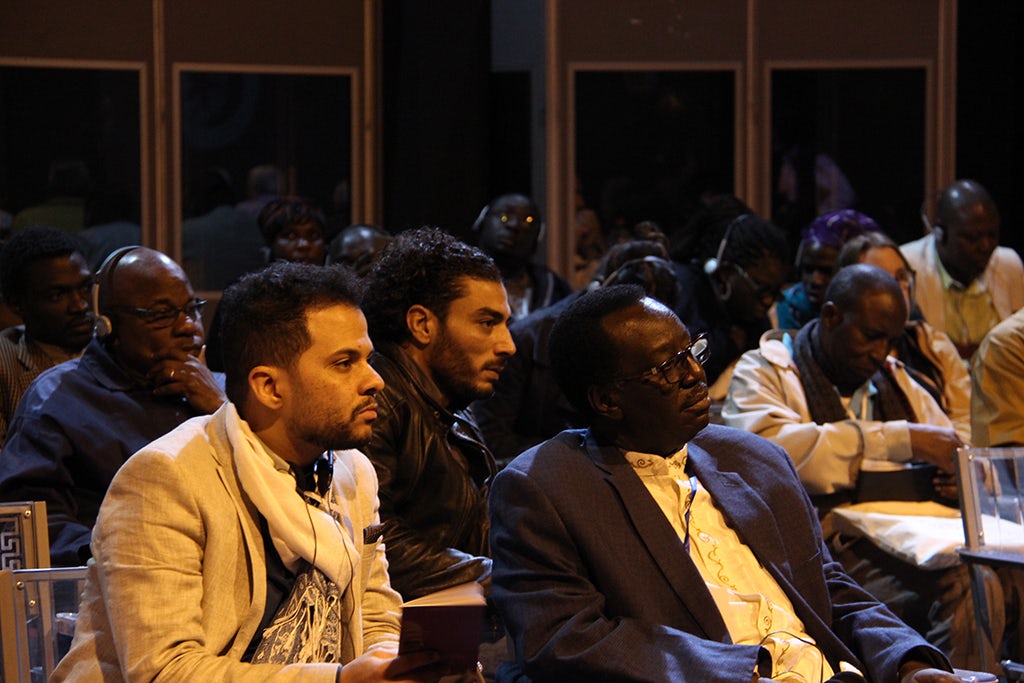
From the presentations it appears that the lack of collaboration between North Africa and sub-Saharan Africa is problematic. Where once the Mediterranean Sea acted as a barrier, now it is the Sahara. There is a strong demand for collaboration between partners within Africa, but it is still an open question as to how that can best be organised or what form is appropriate. Also, the rather one-dimensional aspect of the rencontres does not really contribute to the need for dialogue. In addition, ‘collaboration’ is often interpreted rather narrowly and reduced to the presentation of shows, although it had been announced beforehand that ‘distribution’ would be the main theme of the discussions. This then involves showing one another’s work and a united effort to get work distributed around the world. For instance, efforts are being made to develop an institute that could take on a similar role to that of cultural institutes such as the Goethe Institut or the Institut français, or to develop a fund that could support African creations. It is repeatedly claimed that local cooperation has to be deepened first: you first have to underline the value of art in society and build up a public so that you have the necessary tools to collect funds nationally and internationally, or can transfer part of the costs to the public.
There is a strong demand for collaboration between partners within Africa, but it is still an open question as to how that can best be organised or what form is appropriate.
A practical stumbling block for collaboration within Africa are the often mentioned mobility problems, caused by both visa questions and financial obstacles. The number of examples is, alas, endless. The problematic socio-economic situation in a lot of countries doesn’t help, of course. For instance, a theatre director from Chad recounts how theatre in his country is dying a slow death. Although Chad has large oil reserves, it is one of the poorest countries in the world. The persistent economic malaise makes the situation in the arts sector untenable. The number of festivals has shrunk dramatically and shows are increasingly monologues, in order to compress the costs.
A participant from Syria talks with nostalgia about the high days of theatre in Syria (Damascus was home to the first theatre festival in the Arab region). Because of the ongoing war, the situation is now highly problematic, with an absolute lack of means and mass exodus of artists.
Understandably, the conversations and presentations are often about fundraising, but participants also reflect on ‘means’ other than financial. A network, for instance, can be invaluable. That is ultimately also what JTC does: build up a symbolic capital by means of, among other things, this international platform.
In any case, the festival’s outgoing director, Lassaad Jamoussi, has big plans for Arab-African collaboration. For instance, he announced on the radio that he wishes to set up an international federation for the promotion of African collaboration (‘the confederation of the pan-African festival and events’). In this he has a central role in mind for JTC, which would be the reference par excellence for the presentation of Arab and African work. He also dreams of a sort of ‘African house’ in Avignon, where work could be shown. The focus on Avignon recurs several times during the programme, and raises questions among a lot of participants from Europe. Wasn’t the intention to distance oneself from Western institutes? Are these references really still necessary to legitimise artistic work from the South?
A participant remarks in this respect that the role of the diaspora cannot be forgotten. Refugee or emigrant artists can play a key role in the introduction of African and Arab theatre abroad. Mohamed Ikoubaân (Moussem) applauds initiatives in relation with collaboration, but notes that it is problematic that such an initiative would stem only from state institutions. The independent scene often fails to interact with the state systems and cannot be ignored. Freedom of expression must always take centre stage.
Connections with Europe
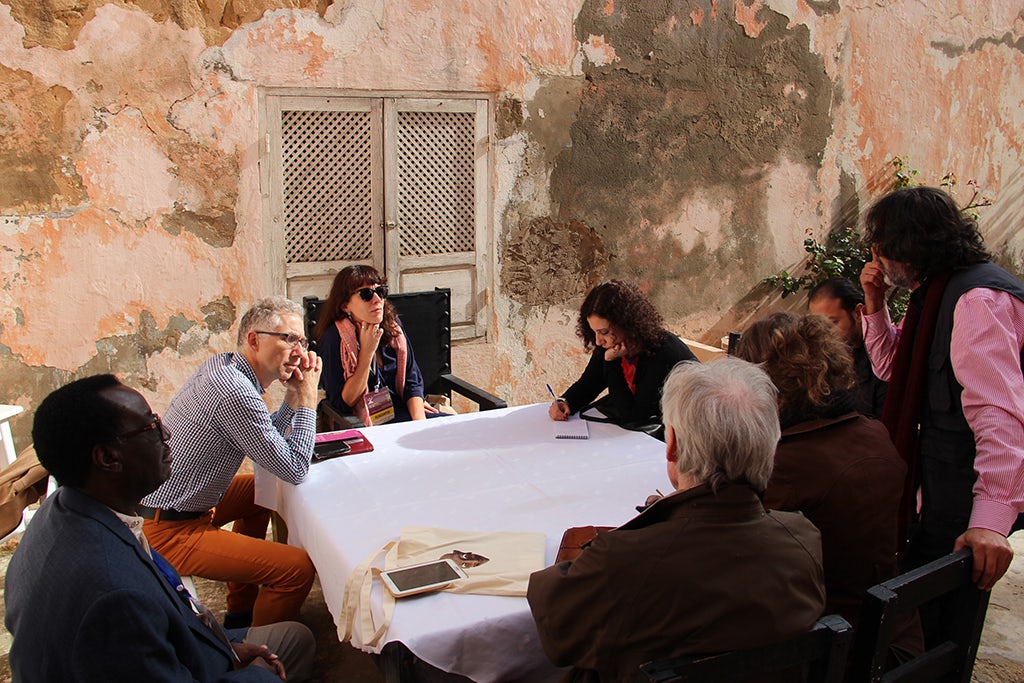
Refugee or emigrant artists can play a key role in the introduction of African and Arab theatre abroad.
On the third day, eight foreign organisations are presented that collaborate closely with the region. Unfortunately, there is not enough time for discussion and dialogue, to see how (other) partnerships could be possible. Mohamed Ikoubaân and Cees Vossen present Moussem. The nomadic arts centre has been actively working for 15 years already with the Arab world (production, presentation, audience activities, reflection, etc.) and has built up a lot of expertise. Moussem also introduces interesting texts from the Arab world in Flanders and started this year with an urban cycle in Brussels, in which each time another city from the Arab region takes centre stage. In 2016 it was Tunis; from 2 to 8 February 2017 it is Beirut’s turn. Shows, installations, exhibitions and artist talks will provide an insight into the city’s dynamics.
Natasja van ’t Westende is the director of Dancing on the Edge, a Dutch organisation that stimulates interaction with the MENA region. They do so by means of a festival, the academy (residencies, co-productions, conferences, etc.) and a programme throughout the year. The development of long-term relations with artists is always of central importance. The multidisciplinary festival ‘Dancing on the Edge’ takes place every two years in various Dutch cities and seeks to offer a platform for contemporary artists from the MENA region. The next festival takes place in November 2017.
The Shubbak festival from London could not be missing, and is presented by artistic director Eckhard Thiemann. This festival was initiated in 2011 by the mayor of London as a one-time event. During the preparations for the festival, the ‘Arab Spring’ broke out, and it soon became clear that it could not be a one-off. An independent organisation was set up and the festival has since been held every two years. The emphasis is always on the artist and not on a specific region. The next festival takes place from 1 to 16 July 2017.
The above three festivals are ideal opportunities for whoever wishes to immerse themselves deeper in work from the region.
Jumana Al-Yasiri also had the opportunity to speak. She is the MENA manager at the Sundance Institute, an American NGO that offers artist residencies and writing workshops, among others, in its theatre programme. Authors are encouraged to keep writing in Arabic and to share mutual expertise.
A Western programming logic
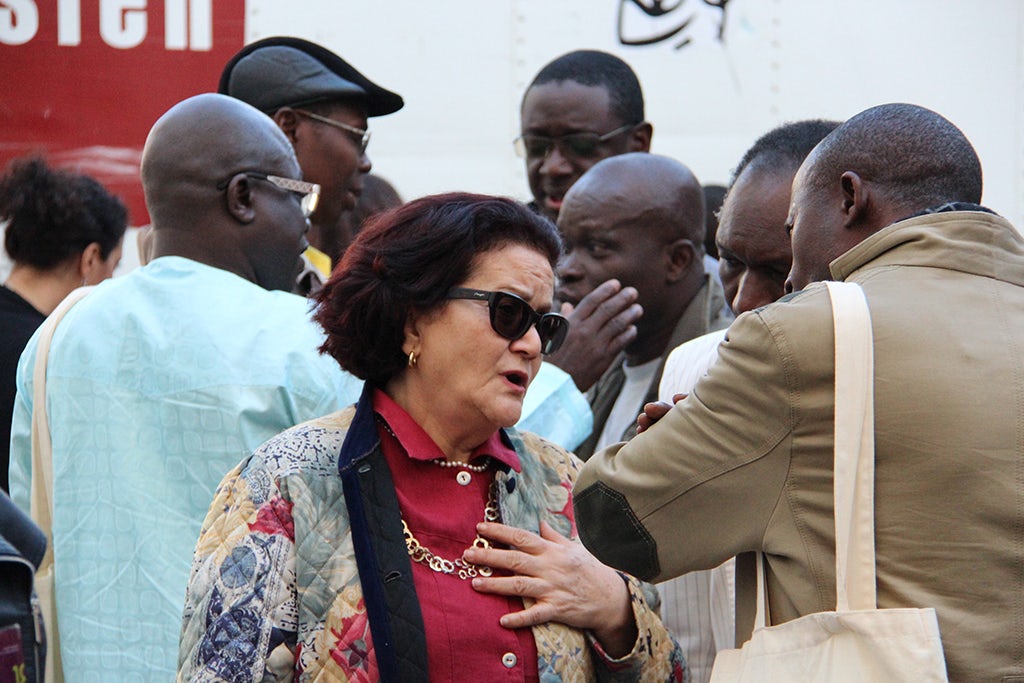
Each artist deserves to be programmed in the first place because of the artistic quality of their work and not because of their origins.
ZEYNEB FARHAT
Zeyneb Farhat, who has been running the independent El Teatro in Tunis for 30 years already, talks about the challenges of the independent scene. El Teatro is mainly focused on South-South relations and offers a platform to artists from the entire region. Farhat laments the lack of well-equipped theatres in the city and set up a network that unites the independent theatres in Tunisia. Most of the theatres in Tunis are run by young people. She also denounces the fact that the programming in the West of work from the Arab region is too closely related to current affairs, a sore point that is confirmed by a lot of participants at the conference.
Western programmers and cultural institutes are too often looking for shows that either satisfy our penchant for exoticism, or take current affairs as their theme (e.g. the ‘Arab Spring’ – a concept contested in itself –, the war in Syria, the refugee crisis, terrorism). Some Syrian artists are now being selected and programmed everywhere, but what will happen when the interest in Syria blows over and the European public looks for something new? Will there be any follow-up? Each artist deserves to be programmed in the first place because of the artistic quality of their work and not because of their origins, says Farhat, who advocates the total freedom of the artist. She mentions a German programmer who found a show in her programme ‘not Arab enough’. Theatre-maker Meriam Bousselmi was asked a similar question during a conversation after her show ‘Un regard sur le monde’. Why were no texts by Arab poets used? Why was it not about Palestine?
After the debates, the discussions continue on the difficulties that framing implies, and how careful you have to be in that regard. Of course, art does not take place in a vacuum and in that sense is always political. As a programmer you want to show certain things because they refer to a current event, and for a public, a thematic focus can be a help. However, a delicate balance is necessary. Natasja van ’t Westende hopes in any case that the term ‘Arab arts’ will be superfluous within the coming years.
Déclaration de Carthage
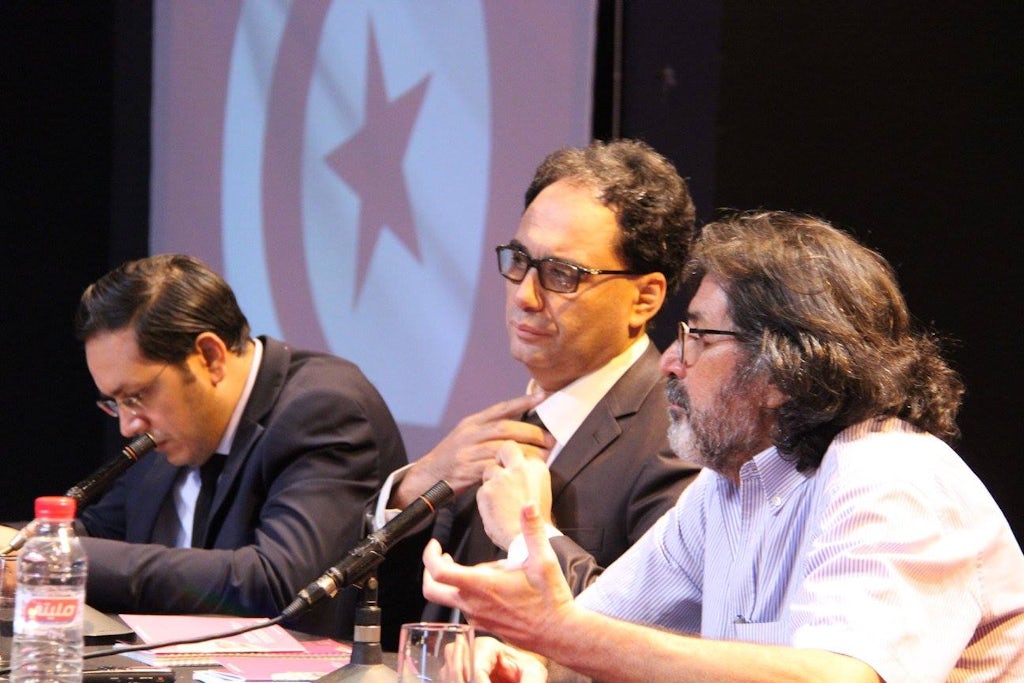
During the festival, the Déclaration de Carthage pour la Protection des Artistes en Situation de Vulnérabilité was also presented, an initiative of a number of academics and activists. Inspired among others by the Universal Declaration of Human Rights and the Geneva Convention, the initiators wish to encourage the international community to mobilise itself for the rights of artists. The declaration calls for the protection of artists in precarious circumstances, who work for instance in conflict or war zones or are persecuted, and where their moral and physical integrity is threatened and they cannot work freely.
The underlying thought is that the protection of these artists, and of artists in general, is a collective responsibility of citizens, civil society and governments. The declaration puts forward a number of concrete measures, such as an international status for artists that would authorise them to practise their profession freely, a visa that would facilitate participation in international collaborations and the distribution of their work, and passports inspired by diplomatic passports, or travel documents for refugee artists. Temporary residence permits for artists are also mentioned, as is the creation of a fund that would help artists with new creations.
Culture Minister Mohamed Zine El Abidine, a musician and former director of the Institut Supérieur de Musique and seventh culture minister in the space of six years, gives an emotional speech in which he declares his support for the declaration, after which all sorts of advocates and civil-society organisations do the same. They hope that the declaration will be adopted by the UN in September 2018. A number of critical voices from the arts field do raise the question as to whether all these nice words will be turned into deeds, and how that will happen.
L’Art Rue and Dream City
It is a pity that the Journées Théâtrales de Carthage does not make a single link with L’Art Rue, the organisation of Sofiane and Selma Ouissi, which seeks to make contemporary art accessible to as wide an audience as possible. Sofiane receives me in their beautiful building, located in the heart of the historical Medina, where artist residencies take place (Thomas Bellinck and Jozef Wouters were in residence here recently) and where they work with school children several days per week. They also have projects in schools. In the project ‘Change ta classe!’, professional artists turn a place in the school into an artistic space and they develop a project together with pupils and teachers. Every two years L’Art Rue organises the multidisciplinary festival Dream City, in which urban utopias are imagined. The next festival – which, like the previous edition, was curated by Jan Goossens – takes place in Tunis in October 2017.
A dark universe
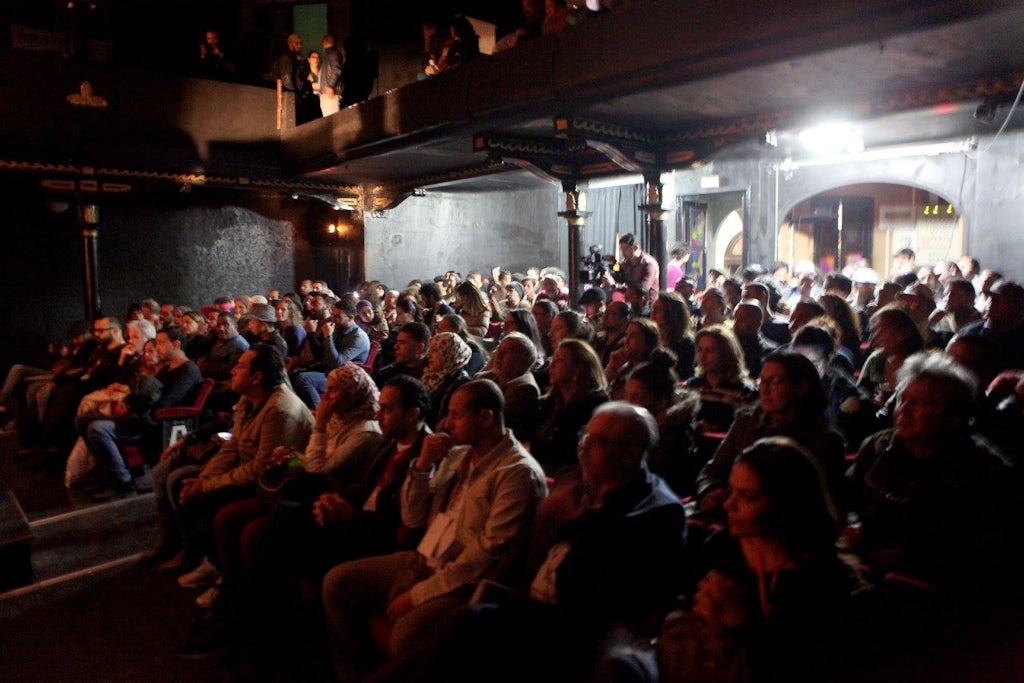
What is striking throughout the festival is that theatre here really ‘lives’ and is an important part of social life.
The theme of most shows in the festival programme reflects the zeitgeist. Whoever was seeking some lightness will have come in vain.
‘Violence(s)’ by theatre icon Fadhel Jaïbi (text: Jalila Baccar) is a two-hour trip that interweaves stories of horror and fear, like a mirror of a society running wild (poster image to this contribution (c) Mohamed Frini). The dance show ‘Yasseem’ by choreographer Chirine Hejazi treats the position of woman in Egyptian society. In ‘Eruption’ by Sliman Bassam (Kuwait), six monologues are blended. The layered text tells the stories of, among others, a young prostitute and an Israeli border guard. ‘Sabotage pour débutants’ by May Saifane and Zied Adouan takes as its starting point the dreams of Syrians, which serve as material for the construction of an ungraspable and dark universe.
In ‘Un regard sur le monde’, the darkness brings release precisely. In this play by the Tunisian theatre-maker and author Meriam Bousselmi, the audience sits in a circle in absolute darkness. Two actresses share their ‘view on the world’ in the form of poetic stories and songs, while they slowly make their way around the circle and spectators sometimes feel their gentle, reassuring touch. In ‘Shubbak’ (‘Window’), Syrian theatre-maker Mejd Fedha tells the story of a young couple that leads an isolated existence and has lost all hope in the future. The man stands before the window to see what is happening outside. The window on the other side sometimes seems to reflect a light. The symbolism of the performance releases many emotions in the (Syrian) spectators.
A hungry audience
What is striking throughout the festival is that theatre here really ‘lives’ and is an important part of social life. The theatres are always full, with a very mixed audience, including a lot of adolescents. And perhaps that is not only due to the low entrance fees of the festival and the young population of Tunisia (about half the population is under 25). On the one hand there is the naturalness with which theatre is part of everyday life, on the other there is the great urgency of makers who use theatre as an ideal platform to map out political and social issues. The spectators also interact more with the performances: they speak up, leave the theatre, take photos during the performance. And young people take selfies after the show in the setting. Food for thought.
Flanders Arts Institute and MENA
As mentioned, Kunstenpunt / Flanders Arts Institute wishes to contribute to the exchange between Flanders and the MENA region and stimulate lasting relations. In doing so we are not only looking for differences, but more so still for what we have in common. And that is more than we thought: concerns about the precarious position of the individual artist (although ‘precariousness’ in the MENA region has another dimension unfortunately), the relation between working locally and internationally; possibilities for art in the public space, new working models, the appeal to a new audience. In 2017 we will begin with a number of exploratory trips in both directions.





